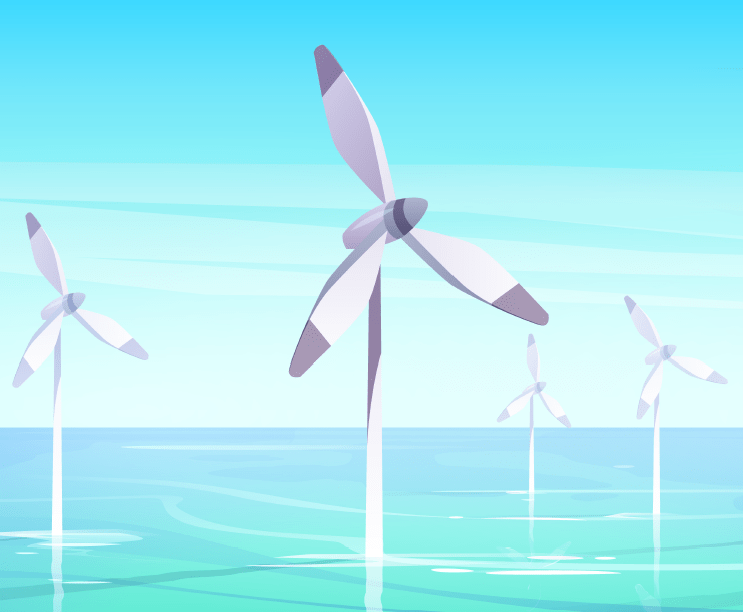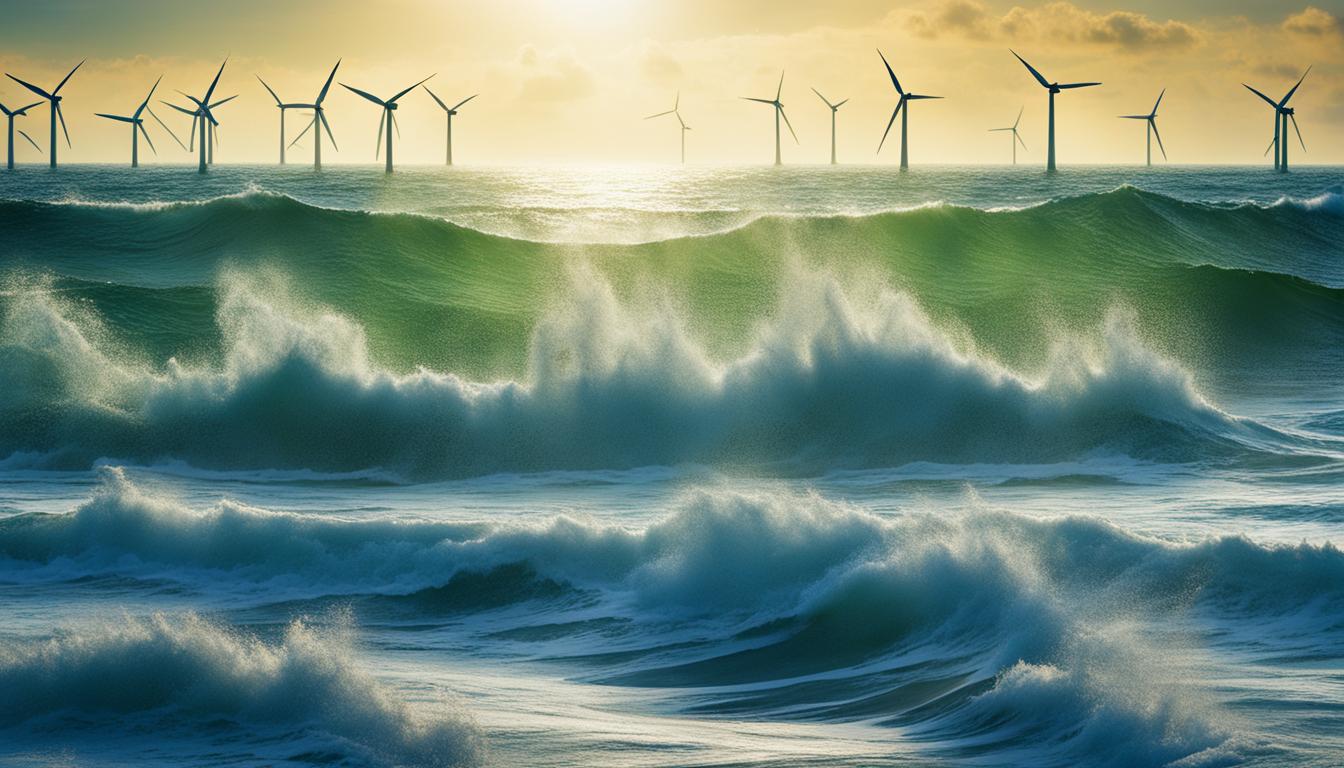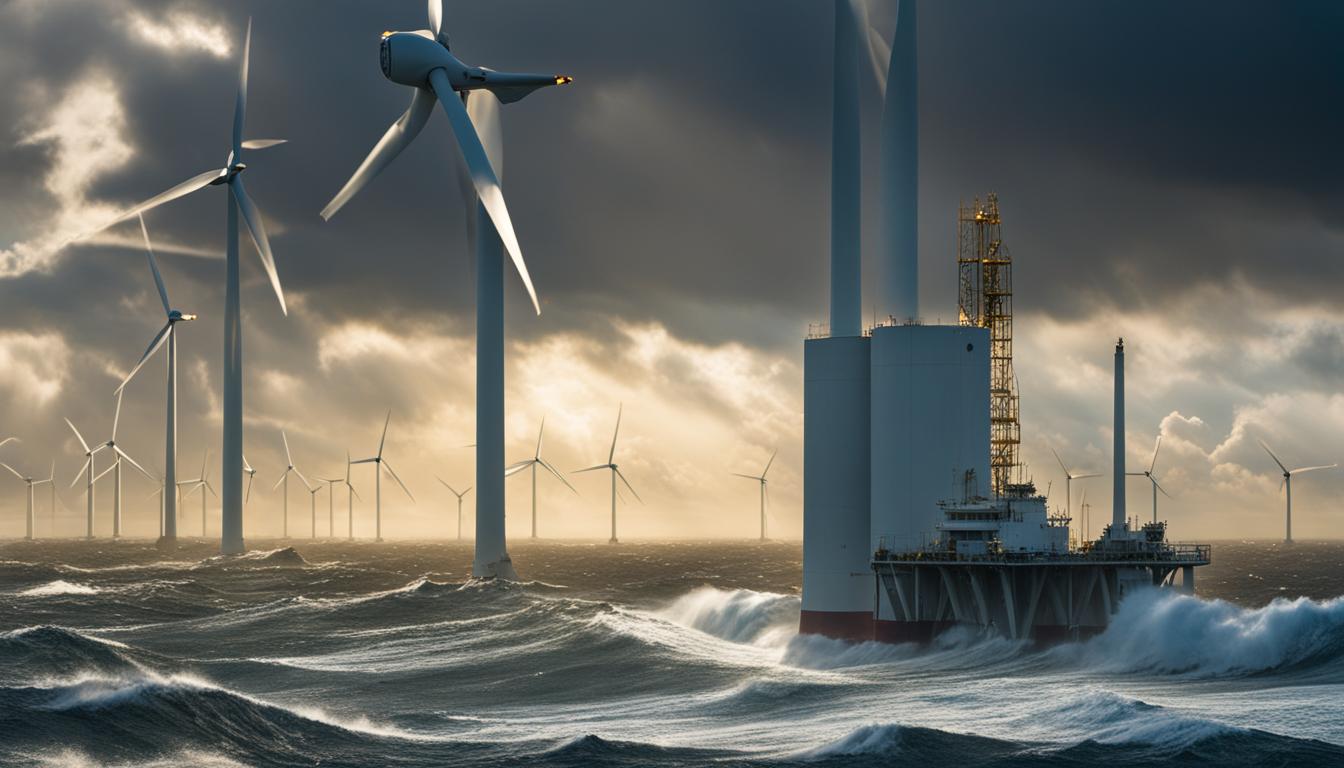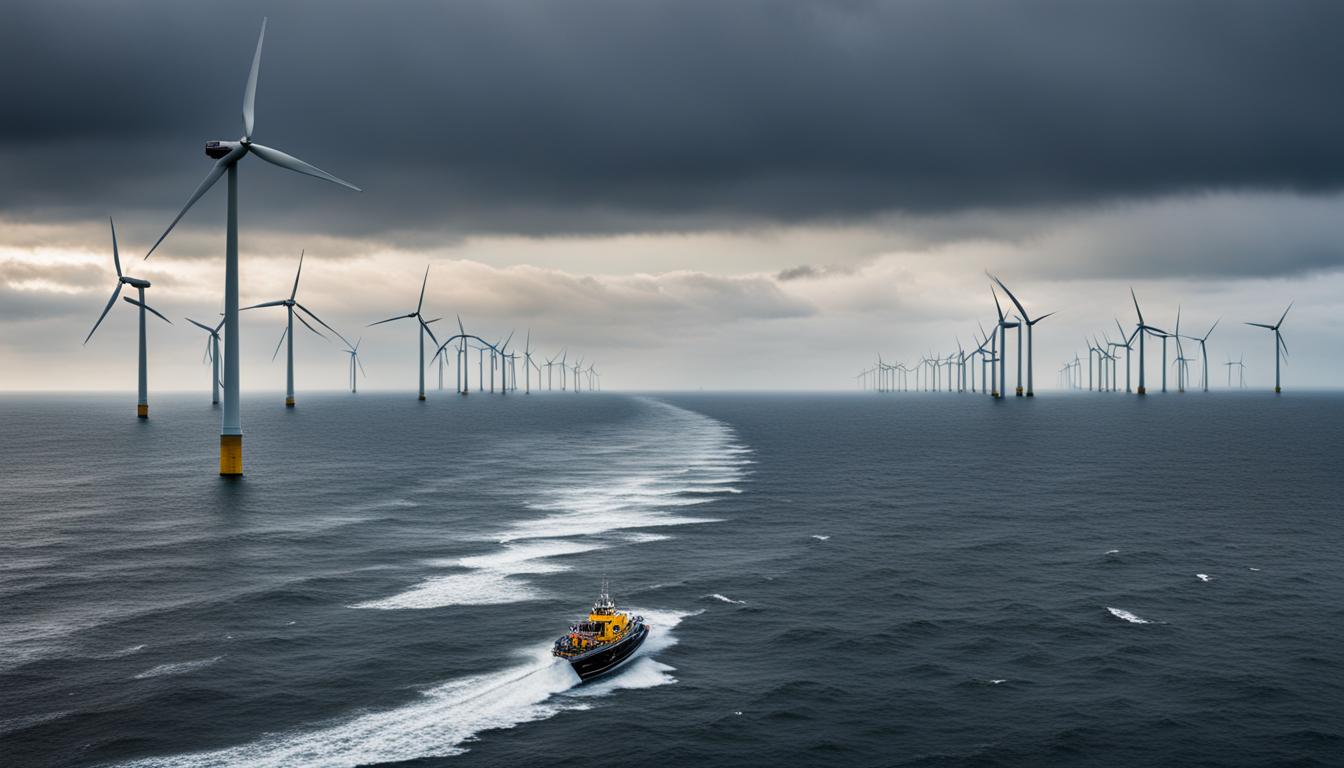Offshore Windpark Insurance in Germany
Offshore wind farms in Germany face various risks including technical challenges, adverse weather conditions, high investment and operating costs.
Insurance solutions are available to protect contractors, manufacturers, and suppliers in the offshore wind industry.
These solutions cover physical damage, accidents, natural hazards, and warranty obligations. Tailor-made insurance policies help mitigate the financial stress caused by losses and ensure the smooth operation of wind park projects.
Inhalt dieser Seite
Key Takeaways:
- Offshore wind farms in Germany are susceptible to technical challenges, adverse weather conditions, and high costs.
- Insurance solutions cover physical damage, accidents, natural hazards, and warranty obligations in the offshore wind industry.
- Customized insurance policies mitigate financial stress caused by losses and facilitate smooth wind park project operations.
Challenges in Offshore Windpark Construction
Offshore windpark construction poses significant challenges due to its complex and large-scale nature. Various factors, such as storms, high waves, and extreme weather conditions, create hurdles in terms of logistics, technology, and material utilization. These challenges require careful planning and innovative solutions to ensure the successful implementation of offshore wind projects.
The installation process of offshore windfarms is carried out in multiple stages, involving tasks such as turbine anchoring and component assembly. Each stage requires precise coordination and collaboration between project developers, investors, governmental authorities, manufacturers, and service providers. This collective effort ensures smooth project execution and helps mitigate risks.
Despite the challenges, the offshore wind sector is still in its early stages, with continuous learning and innovation driving advancements. Ongoing technological developments are expected to improve construction methods, reduce costs, and enhance overall project efficiency. The industry is actively exploring new strategies to overcome obstacles and optimize the construction process.
„Offshore windpark construction poses significant logistical and technical challenges due to the harsh offshore environment. Collaboration among stakeholders is crucial for successful project implementation.“
Key Challenges in Offshore Windpark Construction:
- Adverse weather conditions, including storms and high waves
- Logistical complexities associated with transporting equipment and materials
- Utilization of advanced technology to ensure precise installation
- Mitigating risks related to offshore operations
Efficient management of these challenges is essential to minimize delays, reduce costs, and enhance the long-term sustainability of offshore windpark projects.
Comparison of Offshore Windpark Construction Challenges
| Challenges | Logistics | Technology | Risk Mitigation |
|---|---|---|---|
| Adverse weather conditions | ✓ | ||
| Transportation of equipment and materials | ✓ | ||
| Precise installation | ✓ | ||
| Risk management in offshore operations | ✓ |
By addressing these challenges and leveraging technological advancements, the offshore wind industry can overcome construction obstacles and take advantage of the vast potential that offshore wind energy offers.
Offshore Windpark Insurance Experts for Germany
We at Insurancy are your English-speaking insurance broker from Germany.

What you can expect from us
- No Paper
We work 100 % digitally and your insurance policies are all stored centrally in our app – goodbye file folders! - Do something good with your insurance policies
We donate 20 % of our profits to social and sustainable organisations. Of course, without making it more expensive for you. - Free of charge
Our service is completely free of charge for you, as we are financed purely by the insurance companies. - Independent
We can advise you independently and have access to almost all insurance companies.
Risk Management in Offshore Windpark Operations
During the operational phase, offshore wind parks are exposed to various risks that can impact their efficiency and profitability. Effective risk management strategies are essential to ensure smooth operations and minimize potential losses. One of the key risks faced by offshore wind farms is cable damage, which has been identified as a primary cause of insurance claims in Germany. Additionally, turbine failure and environmental concerns pose significant challenges as well. To mitigate these risks, wind park operators rely on comprehensive insurance coverage and implement proactive measures.
Insurance Coverage for Offshore Windpark Operations
Insurance plays a crucial role in managing the risks associated with offshore windpark operations. Leading insurers like Allianz offer tailored policies that provide coverage for physical damage, business interruption, liability, and environmental risks. These insurance solutions not only provide financial protection but also ensure compliance with regulatory requirements. Insurers work closely with wind park operators to assess their specific needs and design comprehensive insurance packages that address their unique risks and challenges.
Proactive Risk Mitigation Measures
In addition to insurance coverage, wind park operators adopt proactive risk mitigation measures to minimize potential losses and maintain efficient operations. This includes regular maintenance and inspection of equipment to identify and address any potential issues before they escalate. Wind farms also rely on specialized vessels and equipment for efficient maintenance and repairs. These vessels are equipped with advanced technology and experienced personnel to ensure prompt response and minimize downtime in case of any operational issues.
“Effective risk management is crucial for the successful operation of offshore wind parks. By implementing a combination of insurance coverage and proactive risk mitigation measures, operators can protect their assets, minimize losses, and ensure uninterrupted power generation.”
Importance of Quality Service and Industry Expertise
In the offshore wind industry, the availability of specialized service providers and vessels is vital for effective risk management. These service providers offer expertise in maintenance, repairs, and emergency response, helping wind park operators minimize downtime and mitigate potential losses. By partnering with reputable service providers with a strong track record, wind park operators can ensure high-quality service and prompt resolution of any operational issues.
| Risk | Impact | Mitigation Measures |
|---|---|---|
| Cable Damage | Potential power outages, operational disruptions | Regular maintenance and inspection of cablesImplementation of protective measuresComprehensive insurance coverage |
| Turbine Failure | Loss of power generation, costly repairs | Active monitoring and predictive maintenanceRapid response and repairsInsurance coverage for repairs and downtime |
| Environmental Concerns | Compliance issues, reputational damage | Stringent adherence to environmental regulationsMonitoring of environmental impactsImplementation of sustainable practices |
Effective risk management in offshore windpark operations requires a comprehensive approach that combines insurance coverage, proactive risk mitigation measures, and reliable partnerships with specialized service providers. By mitigating risks and ensuring efficient operations, wind park operators can maximize the potential of offshore wind energy and contribute to a sustainable future.
Offshore Wind Industry Growth and Future Projections
The offshore wind industry is experiencing significant growth globally. Currently, Europe and Asia-Pacific dominate the market, but the United States and China are investing heavily and expected to surpass other regions in offshore wind installations. This growth can be attributed to the increasing demand for clean and renewable energy sources.
Future projections suggest that the installed capacity of offshore wind power will increase dramatically in the coming years. It is estimated that 380GW will be added across 32 markets worldwide within the next decade. This expansion is driven by favorable government policies, advancements in technology, and the industry’s commitment to reducing carbon emissions and combating climate change.
However, the offshore wind industry also faces challenges that need to be addressed for sustained growth. Rising costs, supply chain bottlenecks, and permitting delays are key obstacles that need to be overcome. Investments in research and development, innovative solutions, and streamlined regulatory processes will play a crucial role in overcoming these challenges and further driving the growth of the industry.
Despite the challenges, the future of the offshore wind industry is promising. The increasing global focus on renewable energy and the urgent need for sustainable solutions create a favorable environment for the offshore wind sector to thrive. As governments and businesses recognize the value of clean energy, offshore wind power will continue to be a key player in meeting the world’s energy demands while reducing greenhouse gas emissions.
Investment in Offshore Wind Power by Country
| Country | Investment in Offshore Wind Power (USD billions) |
|---|---|
| United Kingdom | $49.4 |
| Germany | $29.9 |
| China | $26.1 |
| United States | $23.6 |
| Netherlands | $19.7 |
The table above highlights the top countries that have made significant investments in offshore wind power. These countries recognize the immense potential of offshore wind energy and are actively working towards expanding their offshore wind installations to achieve their renewable energy targets.
Key Growth Drivers for Offshore Wind Industry
- Government support and favorable policies
- Technological advancements
- Decreasing costs of offshore wind installations
- Increasing demand for clean energy
- Reduction in greenhouse gas emissions
„The offshore wind industry is poised for significant growth in the coming years. Investments in research and development, along with supportive government policies, will play a vital role in driving this growth and ensuring a sustainable future.“
Environmental Benefits of Offshore Wind Energy
Offshore wind energy plays a crucial role in the transition to clean and renewable power sources. With its numerous environmental benefits, it provides a sustainable solution for meeting our energy needs while minimizing the negative impact on the environment.
One of the significant advantages of offshore wind energy is its contribution to reducing carbon emissions. Unlike fossil fuel sources, offshore wind farms produce clean energy without releasing harmful greenhouse gases into the atmosphere. This reduction in carbon emissions helps mitigate climate change and supports global efforts to combat its effects.
Furthermore, offshore wind farms operate for more than 90% of the year, producing green power consistently. This high availability approaches baseload levels, making offshore wind energy a reliable and stable source of electricity.
During the construction phase, the offshore wind industry also prioritizes environmental protection. Measures are put in place to minimize noise pollution and ensure the well-being of marine life. By adhering to strict environmental regulations and implementing sustainable practices, the industry aims to minimize its ecological footprint and preserve marine ecosystems.
„Offshore wind energy is a sustainable solution that reduces carbon emissions, provides reliable power, and protects the environment.“
The responsible development of offshore wind projects aligns with the industry’s commitment to sustainability. Developers and operators strive to minimize the environmental impact of their operations, conducting thorough environmental assessments and implementing mitigation measures to protect fragile ecosystems.
To summarize, offshore wind energy offers significant environmental benefits, including the reduction of carbon emissions, high availability of green power, and the prioritization of environmental protection. As we continue to embrace renewable energy sources, offshore wind plays a vital role in ensuring a sustainable and cleaner future for generations to come.
Offshore Wind Energy and Regulatory Framework in Germany
Germany has established a robust regulatory framework to support the growth of offshore wind energy, ensuring the responsible and sustainable development of wind farms. At the center of this framework is the Renewable Energy Act (EEG), which provides a solid foundation for the industry.
The EEG guarantees compensation for the production of green power generated by offshore wind farms. This not only incentivizes renewable energy production but also provides planning security for investors and operators. The act stipulates fixed compensation rates for a defined period of time, ensuring the prioritization of renewable energy in the grid.
Recently, Germany has transitioned to a competitive auction system for offshore wind energy support payments. Under this system, developers bid for support payments, and contracts are awarded to projects with the most competitive bids. This approach promotes cost efficiency and encourages continuous innovation and technological advancements within the industry.
Environmental protection regulations in Germany are also stringent, with the aim of safeguarding marine ecosystems and minimizing ecological impacts. Developers are required to conduct thorough environmental impact assessments before obtaining permits for offshore wind projects. These assessments evaluate the potential effects of projects on marine life, bird migration patterns, and other environmental factors, ensuring sustainable development and operation of offshore wind farms.
Benefits of Germany’s Regulatory Framework for Offshore Wind Energy
The regulatory framework in Germany provides several benefits for offshore wind energy:
- Financial security for investors and operators through fixed compensation rates and long-term contracts.
- Promotion of cost efficiency and competition through competitive auctions for support payments.
- Environmental protection measures to ensure the responsible development and operation of wind farms.
- Stimulation of innovation and technological advancements within the offshore wind industry.
Germany’s regulatory framework has played a pivotal role in establishing the country as a global leader in offshore wind energy. With a clear commitment to renewable energy and sustainable development, Germany continues to pave the way for a greener future.
| Benefits of Germany’s Regulatory Framework | Description |
|---|---|
| Financial security | Guarantees compensation and planning security for investors and operators. |
| Cost efficiency | Promotes competition through competitive auctions, driving cost savings. |
| Environmental protection | Stringent regulations ensure responsible development and operation of offshore wind farms. |
| Innovation and technology | Encourages continuous innovation and technological advancements within the industry. |
FAQ
What risks do offshore wind farms in Germany face?
Offshore wind farms in Germany face various risks, including technical challenges, adverse weather conditions, high investment and operating costs. These risks can impact the smooth operation of wind park projects.
What insurance solutions are available for the offshore wind industry?
Insurance solutions are available to protect contractors, manufacturers, and suppliers in the offshore wind industry. These solutions cover physical damage, accidents, natural hazards, and warranty obligations.
How do insurance policies help mitigate financial stress in offshore wind park projects?
Tailor-made insurance policies help mitigate the financial stress caused by losses in offshore wind park projects. They ensure the smooth operation of wind park projects by providing coverage for various risks.
What challenges are involved in offshore windpark construction?
Offshore windpark construction involves complex and large-scale projects. Challenges include storms, high waves, and extreme weather conditions that impact logistics, technology, and material utilization.
How is the installation process of offshore wind parks carried out?
The installation process of offshore wind parks is carried out in stages. It involves the anchoring of turbines and the assembly of components. Collaboration between project developers, investors, governmental authorities, manufacturers, and service providers is necessary.
What risks do offshore wind parks face during the operational phase?
During the operational phase, offshore wind parks are exposed to risks such as cable damage, turbine failure, and environmental concerns. Insurance coverage plays a crucial role in managing these risks.
What is the role of insurance coverage in managing risks in offshore wind parks?
Insurance coverage plays a crucial role in managing risks in offshore wind parks. It helps protect against cable damage, turbine failure, and other risks, ensuring efficient operations and minimizing losses.
How is the offshore wind industry expected to grow in the future?
The offshore wind industry is experiencing significant growth globally. While Europe and Asia-Pacific currently dominate the market, the US and China are expected to surpass other regions in terms of offshore wind installations. The installed capacity is projected to increase dramatically in the coming years.
What are the environmental benefits of offshore wind energy?
Offshore wind energy is a key component of the transition to clean and renewable power sources. It contributes to reducing carbon emissions and minimizing environmental impacts compared to fossil fuel sources. Offshore wind farms produce green power for more than 90% of the year.
What is the economic impact of offshore wind energy in Germany?
The expansion of offshore wind energy in Germany has significant economic potential. The sector employs thousands of people across various industries, and total sales along the value chain amount to billions of euros. Further expansion is expected to create additional jobs and drive economic growth.
What is the regulatory framework for offshore wind energy in Germany?
Offshore wind energy in Germany is supported by the Renewable Energy Act (EEG), which guarantees compensation for green power and provides planning security for investors and operators. Environmental protection regulations are also stringent, ensuring the responsible development and operation of offshore wind farms.
Why is offshore windpark insurance crucial?
Offshore windpark insurance is crucial for mitigating risks and ensuring the success of wind farm projects in Germany. As the offshore wind industry expands, the right insurance coverage and risk management strategies are necessary to navigate challenges and thrive in the renewable energy landscape.
Alles rund um das Thema Betreiberhaftpflicht
Independent comparison of over 200 insurance companies
There is a perfect insurance for everyone. We will find the right one for you.









+ 200 other insurance providers
So erreichst du uns
Wir beraten dich Montag bis Freitag von 8 bis 18 Uhr
Oder buche ein kostenloses Webmeeting
- Berechnung aller Kosten Live und per Screensharing
- Lerne uns persönlich, live und in Farbe kennen











